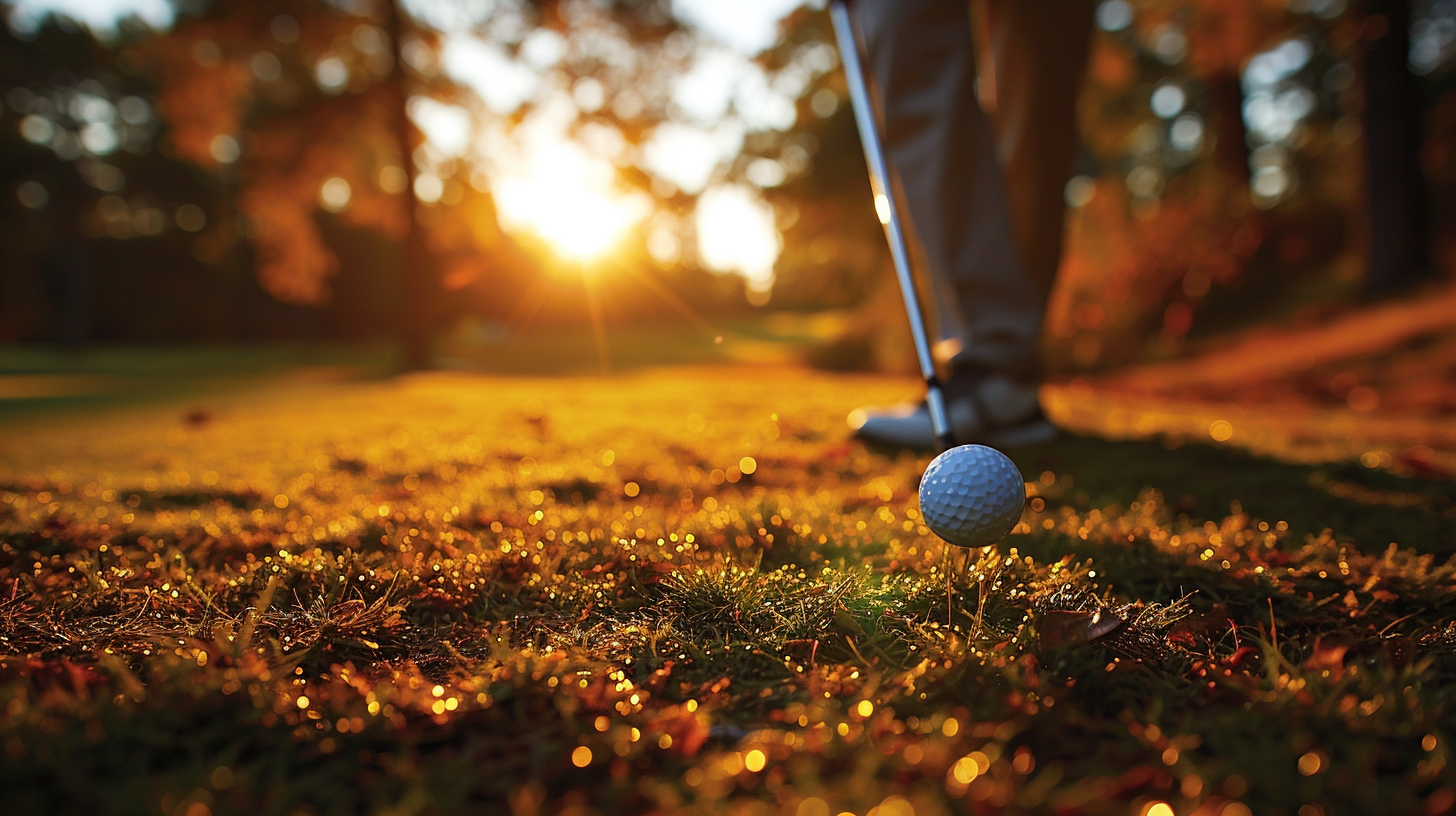Nothing frustrates amateur golfers more than worm burners, slices, and penalty strokes off the tee.
By optimizing stance, grip, swing plane, and weight shift timing, players can banish their big miss and hit frozen ropes down the pipe.
Let’s dive into the keys for pure ball-striking to shoot lower scores.
Proper Stance and Grip

Having the proper stance and grip is essential for hitting a golf ball straight. First, set your feet about shoulder-width apart, with your toes pointed slightly outward. Keep your knees relaxed and slightly bent to allow for optimal balance and weight transfer.
Avoid locking your knees, as this reduces mobility.
Next, align the club face square to your target. Grip the club lightly but securely in your fingers – not the palms of your hands.
The ideal grip pressure allows your wrists to hinge naturally during the swing. Gripping too tight reduces wrist mobility. Position your hands so there are two to three knuckles visible on your trailing hand.
This neutral grip reduces the chance of manipulating the face open or closed.
Hold your arms close against your chest, with your elbows pointing down towards the ground. This tucked position connects your arms to your body’s rotation for maximum power.
Let your arms hang naturally rather than straining to hold them rigidly in place. Maintain this arm and elbow positioning throughout the swing.
Backswing and Weight Transfer

An efficient backswing and weight transfer is key for striking the ball powerfully and accurately. As you take the club back, rotate your shoulders away from the target while keeping your head still.
Pivot your torso as you turn your back to the target. This coils your body, storing power for the downswing.
During the takeaway, the majority of your weight should transfer onto your back foot. Allow your back heel to lift naturally as you coil into your right side.
Shift approximately 75 percent of your weight to your right foot at the top of the backswing. Avoid excessive reverse weight shift, which can cause you to lose balance.
At the top of the swing, make a full shoulder turn so your chest points towards the target. This allows your torso to uncoil explosively during the downswing for maximum clubhead speed through impact.
Impact and Follow Through

For solid contact and straight ball flight, efficient mechanics through impact and follow through are vital. Maintain focus on the back of the ball throughout the swing.
During the transition between backswing and downswing, shift your weight onto your front foot. Time this weight transfer to occur right as the club approaches the ball.
The ideal strike delivers square impact between the clubface and ball. Extend your arms fully towards the target after contact, allowing the club to shallow out naturally rather than consciously releasing the clubface.
Continue rotating your shoulders and torso all the way to a balanced, fully turned follow through position. Complete each swing in a rhythmic motion rather than abruptly stopping after impact.
Maintaining your spine angle during the swing also promotes solid ball striking. Bend appropriately from the hips so your spine angle remains consistent rather than straightening upright.
A spine angle change influences quality of contact. Complete your follow through with torso turned fully to face your target.
Common Mistakes

Several common swing errors contribute to hitting shots off line. Swaying sideways or excessively sliding your hips during the backswing disrupts balance and alignment.
Make sure to rotate rather than sway for optimal ball striking. Additionally, releasing the club too early or casting outward reduces control and consistency.
Allow your arms to extend fully towards the target after impact rather than consciously releasing the clubface.
In addition to swaying issues, improper weight shifts also cause mis-hits. Failing to transfer your weight onto your front foot during the downswing makes clean contact difficult.
Learn to re-center your mass to in front of the ball at impact. Besides inconsistent ball striking, not shifting forwards promotes thinning shots.
Besides weight transfer problems, mis-hits also stem from technical factors like poor posture and arm positioning. Bending your front arm too soon during the takeaway encourages hitting behind the ball and making fat contact.
Cupping your wrists prematurely also contributes to this issue. Keep your front arm straight and wrists neutral during the initial phase of the backswing.
Maintaining proper spine angle and avoiding excessive lowering or raising of your upper body is also key. Poor posture contributes significantly to mis-hit shots.
An upright stance at impact often produces tops and skulls. Conversely, dropping your upper body angle too much tends to cause chunked shots and thin contact.
Helpful Drills

Implementing key practice drills builds more efficient swing technique for hitting it straight. Perform one-handed swings to prevent overactive hands from manipulating the face open or closed.
Make smooth, controlled swings while keeping the clubface square. You can perform one-handed motions with either arm to enhance feel.
Hitting shots with your feet together also promotes correct weight shift timing. With no space between your feet, you learn to drive weight forwards not sideways during the transition.
The feet together position timed with proper torso rotation spikes straight shot consistency.
Try the classic gate drill as well. Place two clubs parallel to each other about two inches apart to guide your swing plane.
Groove an inside takeaway by taking the club back low to the inside of the gate without making contact. On the downswing, do the opposite by bringing the clubhead to the outside of the clubs.
You can also place an object about one inch in front of your golf ball’s intended path. Practice brushing against this object like a tee on the way down without moving it.
This engrains an in to out swing path for enhanced directional ball striking.
For added feedback on body motion, position your front foot over a towel during practice swings. If you lose posture or sway laterally, your foot will move the towel.
Keeping it stationary encourages correct rotational movement for striking shots straight.
An additional useful drill involves making an exaggerated shoulder turn at the top of the backswing. This engrains fully loading into your trail side while coiling your core muscles.
Perform this motion without a club first before incorporating it into full swings. Moving your shoulders vertically rather than rotating around your spine reduces effectiveness.
Implement these golf tips and drills to optimize your form. Proper posture, grip, and swing mechanics provide the foundation for hitting shots straight more consistently.
Conclusion
Mastering the proper golf swing mechanics provides the techniques needed to hit consistently straight shots. With correct set-up, weight transfers, impact positioning, and drill training, golfers can ingrain efficient form.
Staying balanced while making a full shoulder turn and clearing the hips stacks the odds for solid ball-striking. Implement these golf tips to notch pars and attack pins with premier iron play.



